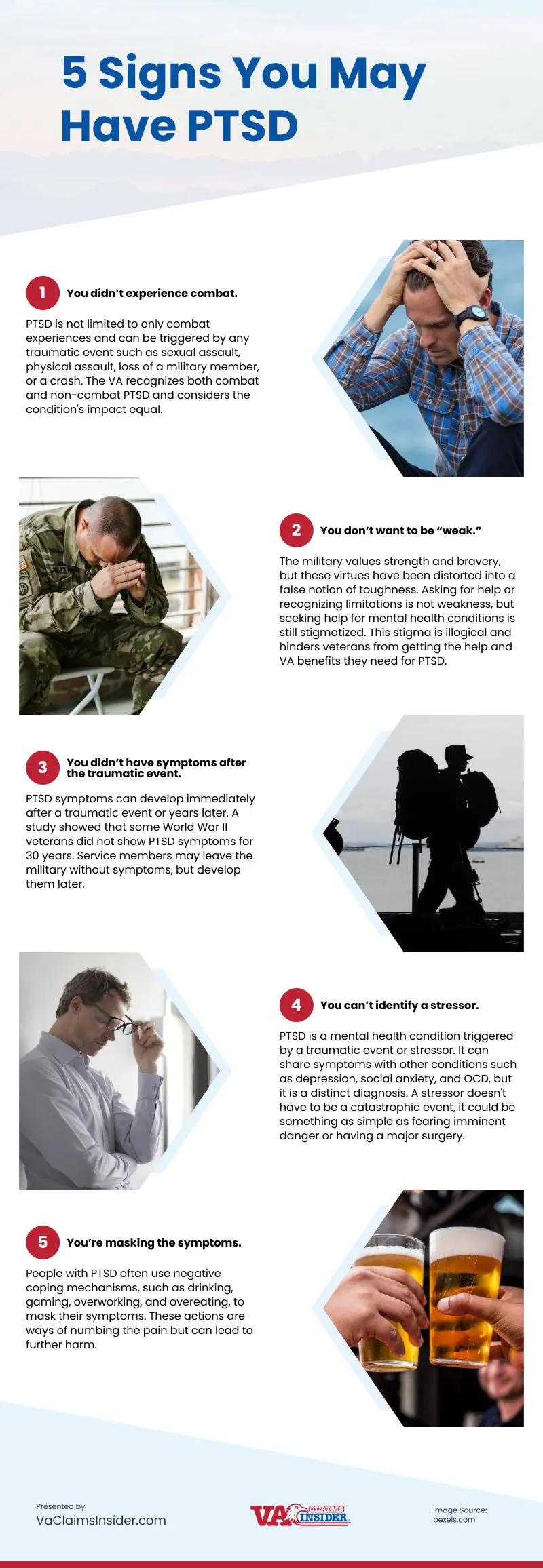
Many associate post-traumatic stress disorder or PTSD with battle, but many veterans also experience non-combat PTSD. They fail to properly represent those who may not even be aware that they have PTSD, as well as others who may have it but do not seek a diagnosis or therapy.
Are you possibly experiencing symptoms of PTSD without being aware of it or receiving the necessary care? If so, you are not by yourself. Veterans far too frequently suffer in silence in the depths of PTSD.
Here are five explanations for why you might be overlooking PTSD symptoms:
1. You didn’t take part in the battle
Everyone who has gone through or witnessed a stressful event, often known as a “stressor,” is actually at risk for developing PTSD. Although PTSD can be brought on by stressors, war is not the sole situation that can do so. There are many PTSD triggers for military personnel, and they can be just as crippling whether they happen in or outside of war. The VA will treat the effects of PTSD with equity and acknowledge both combat and non-combat PTSD.
2. You don’t want to feel and look weak
The military sets a high priority on toughness and gallantry and for good reason. They are essential in combat. These traits, however, have been distorted by societal preconceptions and stereotypes into something they were never meant to be: a tough person who hides what’s really going on inside.
Is seeking the assistance you require being weak? Is openly recognizing a limitation and working to overcome it weak? It is illogical and counterproductive to stigmatize mental health issues, which may prevent you from acknowledging your PTSD and receiving treatment and VA benefits.
3. The traumatic event didn’t cause you any symptoms
Many people have PTSD symptoms three months after the traumatic event, while some people may not experience them for years. It happens frequently for service personnel who leave the military with no noticeable signs of PTSD, only to experience these symptoms months or years later. In some circumstances, a stressor later in life (such as a job loss or a death in the family) might cause PTSD from a previous traumatic incident.
4. A stressor cannot be identified
Numerous other mental health illnesses, such as depression, social anxiety, and OCD, can have PTSD-like symptoms. However, although PTSD and these other diseases have some of the same symptoms, PTSD is a unique diagnosis that resulted from a traumatic event or stressor.
Veterans who don’t have a specific stressor may search for alternative diagnoses while still struggling with PTSD. Keep in mind that the stressor does not have to be a catastrophic occurrence. It’s also critical to understand that simply because you are unable to recall a trauma, it didn’t actually occur. The brain is a very resourceful organ with a built-in defense mechanism.
5. You’re masking the symptoms
Drinking is a typical coping mechanism for people living with PTSD. There are positive and negative ways of coping. Drinking is a detrimental form of coping when trying to manage PTSD symptoms. There are other methods besides alcohol for dulling pain. It’s normal for people to “negatively cope” with their PTSD by engaging in other addictions, such as gaming, excessive work, overeating, etc.
It’s time to get the support you need and have a right to under the law if you believe you may have PTSD. You could be eligible for a PTSD VA rating of 100%, subject to the level of severity of your disease.
To gain a diagnosis for your treatment, make an appointment with your doctor (either a VA or private physician). Don’t try to hide what you’re going through, even if it means having some awkward talks. Provide all supporting documentation for your PTSD diagnosis and be prepared to speak openly about your symptoms and how they affect you and those around you. Additionally, you want to ask for an IMO (Independent Medical Opinion) or a Nexus letter tying your illness to your time in the military.
source: https://vaclaimsinsider.com/are-you-living-with-ptsd-without-realizing-it/
Comments
Download this infographic.
